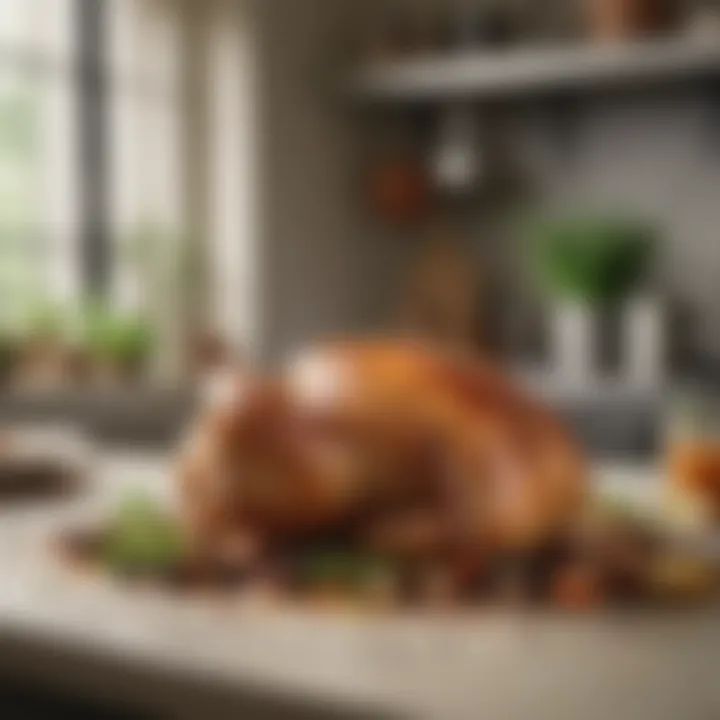Mastering the Art of Roasting a Three-Pound Chicken


Intro
Roasting a chicken may seem like child's play to some, but achieving a succulent, golden-brown masterpiece requires a bit of know-how. A three-pound bird provides just the right size for a family dinner, yielding juicy meat and crispy skin that can make anyone weak at the knees. From preparation to the final golden touch, every step plays a crucial role in the outcome.
This guide will walk you through the essential stages of roasting this avian delight. You’ll gather tips that range from selecting the right chicken to fine-tuning cooking times. Let’s dive into the delicate dance of flavors and textures that comes together in perfect harmony when you master the art of roasting a three-pound chicken.
Recipe Overview
Recipe Name
Classic Roasted Chicken
Description of the Dish
This dish is a timeless classic that highlights the simplicity and beauty of roasting. The chicken, seasoned to perfection, emerges from the oven with a crispy skin that crackles with every bite, while the tender meat beneath oozes flavor. With just a few staple ingredients and some thoughtful techniques, the outcome will be a comforting meal that warms the heart.
Ingredients
List of Ingredients with Measurements
- 1 three-pound chicken
- 2 tablespoons olive oil
- Salt and pepper (to taste)
- 4 cloves garlic, minced
- 1 lemon, cut into wedges
- Fresh herbs (like rosemary and thyme), a handful
- 1 onion, quartered
Special Notes on Ingredients
When it comes to selecting your chicken, fresh is best, but you could use frozen too, just make sure it's fully thawed. Regarding herbs, feel free to mix and match based on what you have on hand; dill or parsley also work like a charm. And if lemon's not your thing? Don't sweat it! Try limes or even oranges for a different twist.
The key to a great roast is to enhance natural flavors while ensuring they remain moist. So, let's roll up our sleeves and get cooking!
Prelude to Roasting Chicken
Roasting a chicken, particularly a three-pounder, is more than just a cooking method; it's a time-honored tradition that brings families and friends together. Understanding this art form can transform a simple meal into a memorable experience. In this article, we will explore not only the technical aspects of roasting a chicken but also the underlying principles and joys that come with mastering this culinary skill.
Roasting a chicken allows for a fantastic array of flavors to develop. The rich, crispy skin combined with the succulent meat is hard to resist. It embodies comfort food at its finest, often sparking nostalgia as you recall family dinners or holiday gatherings. Such connotations elevate a roast chicken from mere sustenance to a centerpiece of celebration.
Moreover, roasting preserves the integrity of the chicken's moisture while enhancing its natural flavors. Throughout our discussion, we will touch on various methods and techniques that can accentuate this experience, whether you are a novice or a seasoned cook. The risks of drying out the bird, undercooking it, or not achieving the desired flavor will also be addressed, ensuring that your endeavors in roasting are successful.
A perfectly roasted chicken showcases the harmony of technique and intuition.
In essence, mastering this skill is not only about the time spent in the kitchen but also about producing a meal that can create memories. Whether hosting a dinner or preparing a weeknight meal for the family, roasting a chicken offers versatility and elegance. The journey through roasting will equip you with the knowledge needed to impress at any table.
The Appeal of a Roast Chicken
The allure of a roast chicken is deceptively simple yet profound. It’s the comfort of home, the satisfaction found in the aromatic blend of savory seasonings, and the anticipation of a perfectly cooked feast drawing us toward this dish. When you crack open that oven door, and a waft of warm, fragrant air hits you, it’s like an embrace. There's a sense of accomplishment tied to producing such a delectable meal.
Roasting allows flavors to meld beautifully. A well-cooked chicken often carries subtle hints of garlic, rosemary, or thyme, inviting you to indulge. Moreover, the art of roasting a chicken doesn't limit you to the bird itself. The drippings can be easily transformed into gravies or sauces, enhancing the dining experience and providing an added layer of richness to your meal.
This dish also holds a universal quality; it can satisfy both the carnivore and the more discerning palate. From families to gourmet chefs, it graces tables across cultures—each adding their unique twist. Simply put, the appeal of a roast chicken lies in its ability to unify tastes and create moments.
Understanding Chicken Cuts and Weights
When it comes to roasting, grasping the nuances of chicken cuts and their respective weights is paramount. Most kitchens choose chicken based on the total weight, and a three-pound chicken serves beautifully for many purposes. It’s substantial enough for family dinners yet manageable for smaller cooking environments.
In culinary terms, chicken is often classified into various cuts: the breast, thighs, wings, and drumsticks. Each part contributes differently to the overall taste and texture of the dish:
- Breast: This part is lean and cooks quicker, often leading to dryness if not handled carefully.
- Thighs and Drumsticks: These cuts possess more fat, providing moisture and richness even if cooked for longer times.
- Wings: Perfect for appetizers, they can be roasted alongside the whole chicken for added flavor.
By understanding these cuts, you can select the right chicken that complements your cooking intent. A three-pound whole chicken is often chosen for roasting due to its balance of meat and bone and the ability to attain an even roast across various parts.
Measuring cooking times by the weight ensures that every portion reaches the appropriate doneness, making the journey of roasting less daunting. For instance, knowing that a three-pound chicken generally requires about an hour and fifteen minutes to reach that golden-crisp perfection takes the guesswork out of the process.
With these foundational concepts in mind, diving into the preparation will become a seamless, enjoyable process.
Selecting the Perfect Chicken
Choosing the right chicken sets the stage for success when roasting, especially if you're aiming for that ideal three-pound bird. You want flavor, tenderness, and juiciness right from the get-go. The selection process is not merely a fleeting decision but a significant factor that influences the overall outcome. Whether you’re cooking for family or hosting a gathering, the chicken's quality is crucial. Good poultry can elevate your dish, while subpar choices might leave you with something rather lackluster.
Fresh vs. Frozen Chicken
When it comes to freshness, there's often a debate between fresh and frozen chicken. Fresh chicken, generally speaking, might have a more favorable texture and flavor. It tends to be less watery compared to frozen counterparts, which can sometimes be injected with a saline solution to extend shelf life. Having a fresh chicken means that it will be juicier after roasting, often yielding a better-tasting meal.
On the flip side, frozen chicken has its perks, particularly concerning convenience and price. It often comes at a lower cost and can be stored for much longer. If you opt for frozen, make sure to give it ample time to thaw. A good rule of thumb is to leave it in the refrigerator overnight. Rapid thawing techniques, like submerging in cold water, can work, but they may lead to uneven thawing or water-logged meat. While both fresh and frozen can work, the key here is to recognize your needs and schedule, weighing convenience against optimal flavor.
Organic and Free-Range Options


Specialty categories like organic and free-range chickens often entice those seeking superior quality. Organic chickens are raised without antibiotics or hormones and fed organic feed, making them appealing for health-conscious consumers. They usually roam freely, leading to a diet supplemented by foraging. This lifestyle often translates into more flavored meat, and therefore, a better roasting experience.
Free-range chicken also garners attention for its raised conditions, allowing birds to wander outside. This kind of treatment not only promotes ethical farming but can greatly affect meat quality as well. Many chefs swear by the distinct taste of free-range birds, citing richness and depth of flavor.
In summary, when selecting chicken, remember that every choice carries its nuances. Your decision between fresh and frozen or organic and free-range will significantly impact the final dish you serve. Make sure to consider your personal preferences, dietary needs, and of course, your budget.
"The chicken you choose is just as important as the methods you employ. A happy, healthy chicken often translates to a happier meal."
By understanding the fundamentals of chicken selection, you empower yourself to create memorable meals with every roast.
Preparation Techniques
When it comes to roasting a perfectly succulent chicken, preparation is king. The right techniques can transform an ordinary bird into a culinary centerpiece worthy of any table. Preparation techniques not only enhance flavor but also ensure that the chicken cooks evenly and retains its moisture. Here, we'll dive into essential methods that set the stage for a well-roasted chicken.
Defrosting and Brining
Before you reach for those herbs and spices, the chicken should be properly defrosted. If using frozen chicken, place it in the refrigerator a day in advance, allowing it time to thaw gradually. This method helps maintain texture and flavor.
Brining takes things up a notch. Soaking the chicken in a saltwater solution before cooking can yield astounding results. A simple brine, made with water, salt, and sugar, helps the meat to absorb moisture and flavor before it even hits the oven. Some folks even swear by adding seasonings to the brine, like garlic or bay leaves, to pump up the taste.
Seasoning the Chicken
The art of seasoning is crucial for a roast as it directly impacts the final flavor. Here, we consider three main avenues to explore.
Herbs and Spices
Herbs and spices are the unsung heroes of flavor. Adding them during the preparation contributes layers of taste that work wonders. For instance, rosemary stands out for its earthy tone and pairs beautifully with chicken. Thyme, on the other hand, brings a subtle warmth.
Notably, fresh herbs often lend a brighter profile compared to dried ones, which carry a more concentrated flavor. While they can be more fleeting in taste, incorporating a blend can create a symphony of flavors that tickle the palate. Remember, too much of a good thing can overwhelm, so add with care.
Salt and Pepper
Salt and pepper are simple yet vital. Salt serves to enhance all other flavors and aids in moisture retention. It's like the backbone of seasoning.
Using freshly ground pepper brings unmatched freshness to even the humblest of dishes. A little sprinkle goes a long way in creating that sought-after depth. However, poor-quality salt or overdoing it can easily lead to a briny disaster, so moderation is key.
Citrus and Other Aromatics
Citrus adds zing. Slicing up a lemon or orange and tucking them inside the chicken cavity not only infuses flavor but can aid in tenderizing the meat, thanks to their acidity.
Aside from fresh herbs, aromatic additions, like garlic and onion, packed around the bird kick-start things. These ingredients release their natural oils and sugars while roasting, enveloping the chicken in a flavorful embrace. Nonetheless, care must be taken not to overpower the delicate flavors of the chicken itself.
Trussing Techniques
Trussing involves tying the legs and wings close to the body of the chicken, helping it to cook evenly while keeping those precious juices inside.
While many skip this step, doing so prevents the tips from burning and ensures a better presentation. A simple piece of kitchen twine is all that's needed. The idea is not to make it too tight but snug enough to hold everything in place. Traditional trussing creates a compact shape, promoting uniform cooking and, ideally, a more succulent bird.
Proper preparation lays the groundwork for a delightful roast chicken experience. If you take the time to prepare wisely, your effort will surely show come serving time.
Cooking Methods
The method you choose to cook your chicken plays a significant role in the final outcome of your meal. Different techniques bring out unique flavors and textures, catering to varying preferences and skills. Understanding these methods can make a world of difference; whether you're after crispy skin, juicy meat, or a blend of both, each approach offers its own advantages. Let's take a deep dive into three primary cooking methods for roasting a three-pound chicken, each with its distinct flavor profile and attributes.
Traditional Oven Roasting
Roasting a chicken in a traditional oven is akin to stepping into a timeless culinary tradition. This method allows for even heat distribution, ensuring that all parts of the chicken cook thoroughly.
Here's what to note:
- Temperature Control: Maintaining the right temperature is crucial. Generally, roasting at 375°F gives a nice balance of crispiness and juiciness.
- Basting for Flavor: Basting the chicken with its own juices enhances flavor and keeps the meat moist. A simple blend of olive oil, butter, or even chicken broth can be used.
- Resting the Bird: Post-roasting, it’s essential to let the chicken rest. This allows the juices to redistribute, making each slice tender.
Using a few simple spices and herbs can transform the entire experience. Thyme, rosemary, and garlic can create an aromatic feast that fills the kitchen with mouth-watering scents. Don’t forget to season beneath the skin for an extra punch of flavor!
Rotisserie Options
Rotisserie cooking is like having a party on a spit. The bird slowly revolves over heat, allowing the skin to crisp up while the inside stays tender and juicy. This cooking method is often seen at outdoor barbecues and brings a smoky flavor that's hard to replicate in an oven.
Consider these key points:
- Self-Basting: As the chicken spins, its juices continuously baste the meat. This natural self-basting minimizes the need for extensive monitoring during cooking.
- Time-efficient: A rotisserie can cook a chicken evenly in less time than you might think. Shifting heat helps cook the chicken inside out.
- Great for gatherings: There’s something visually appealing about cooking an entire bird this way — it becomes the centerpiece at a gathering.
If you have the option to use charcoal or wood chips for flavor, it deepens the smoky notes, enhancing the overall taste. The method is not only practical, but also presents a feast for the eyes, enticing guests before they even take their first bite!
Slow Cooking Approach


If you are looking for a fuss-free way to achieve succulent chicken, the slow cooking approach could be your best bet. This method involves using a slow cooker, where the chicken cooks slowly at low temperatures for an extended period.
Here are a few highlights:
- Set it and Forget it: Simply season the chicken, place it in the slow cooker, and let it do its magic. This is perfect for busy cooks or those who prefer to prepare meals days in advance.
- Enhanced Flavor Through Time: Slow cooking allows flavors to meld beautifully. Herbs, spices, and any added ingredients permeate the meat, creating a rich taste that’s hard to beat.
- Inviting Aroma: The steady cooking process emits a comforting aroma throughout the home, beckoning everyone to the dinner table.
Incorporating some veggies, like carrots or potatoes, can add depth and create a complete meal with minimal effort. Just make sure to keep an eye on the cooking time; it can vary, and you’ll want to ensure the chicken is cooked through well without falling apart.
"Each cooking method offers a delightful experience in its unique way, enhancing the ordinary bird into an extraordinary meal."
Knowing these methods allows you to pick the best option tailored to your timeframe, taste preferences, and the equipment at your disposal. Each technique can bring something special to your roasted three-pound chicken, so experiment and see which one becomes your favorite!
Monitoring Cooking Times
When it comes to roasting a chicken, monitoring cooking times is critical. Cooking a three-pound chicken to perfection relies not just on how it’s prepared but on how it's cooked—this means keeping a close eye on the timing. Inadequate attention to cooking time can lead to a dry or undercooked meal, making monitoring a significant aspect of this culinary art.
Calculating Time Per Pound
Calculating the time per pound is one of the most straightforward methods to ensure your chicken comes out just right. A general rule of thumb is to allocate approximately 20 minutes per pound at a temperature of 350°F (175°C). So, for a three-pound chicken, you’d be looking at about one hour in the oven.
It’s essential to remember that your oven's actual performance can vary based on factors like brand, age, and any hot spots inside it. Here are some focused points to consider:
- Oven Calibration: If your oven isn’t calibrated, adjust the cooking time accordingly. An underperforming oven could require extra time, while a hotter one might cook faster.
- External Factors: Things like opening the oven door too frequently can result in heat loss, causing longer cooking times.
- Cooking with Stuffing: If you stuff your bird, add about 30 minutes to the overall cooking time.
Using a Meat Thermometer
Investing in a good meat thermometer can save you a world of trouble, even for an experienced cook. Relying solely on cooking times can often lead to unexpected surprises, while a thermometer takes the guesswork out of the equation. The USDA recommends that chicken be cooked to an internal temperature of 165°F (75°C).
The key here is knowing where to insert the thermometer—a common mistake is positioning it in the thickest part of the bird, into the breast or thigh, without touching the bone. Here’s how to ensure you’re on the right track with this tool:
- Choose the Right Thermometer: A digital instant-read thermometer is usually the most reliable.
- Placement: Insert it into the inner thigh but not touching the bone or the stuffing, if there is any.
- Allow Carryover Cooking: Remember that the chicken will continue to cook even after you take it out of the oven due to residual heat, so consider this when checking the final temperature.
"A well-cooked chicken should have a golden-brown skin and juicy meat that practically falls off the bone."
Enhancing Flavor with Side Dishes
Cooking a roast chicken can feel like stepping into an exciting culinary landscape, but it’s far from a solo performance. The flavors of the chicken can be dramatically uplifted by the thoughtful choice of side dishes. They harmonize, balancing out the rich, savory elements of the roast, creating a symphony of flavors on your plate. Think of side dishes as not just supporting characters but vital players in this delicious drama.
Roasted Vegetables
When it comes to flavor enhancement, roasted vegetables are a classic go-to. Roasting brings out the natural sweetness in veggies, a fact that can easily turn any unassuming carrot or potato into a star of the meal. Imagine vibrant bell peppers, hearty sweet potatoes, and earthy root veggies tossed with a little olive oil, salt, and pepper before they hit the oven. As these colorful companions roast alongside your chicken, they absorb the drippings and render in the oven’s heat, creating a delightful mingling of flavors. Here are a few tips for getting it just right:
- Choose the Right Vegetables: Select vegetables that cook evenly and complement the chicken. Carrots, parsnips, and Brussels sprouts are excellent choices. Even feel free to experiment with seasonal veggies for variety.
- Cut Uniformly: To ensure proper cooking, cut them to similar sizes. This way, everything finishes roasting around the same time.
- Season Generously: Don't skimp on the seasonings. Fresh herbs like thyme or rosemary can push the flavors over the edge. A sprinkle of garlic can’t hurt either.
As these vegetables approach perfection in the oven, they meld together with the essence of the chicken. That tantalizing aroma wafting through the home can be just as important as the flavor once it hits the plate. The connection between a well-roasted chicken and its vegetable companions is a culinary dance that no one should miss.
Savory Gravy Options
A well-crafted gravy can elevate a dish to heights that others simply cannot reach. The drippings from the chicken hold an abundance of flavor, begging to be turned into a silky gravy. This is where your side dish game really shines; pouring rich gravy over roasted vegetables or fluffy mashed potatoes enhances their profiles, tying everything together beautifully.
- Using the Drippings: After roasting, don’t forget to collect those drippings from the pan. They are the lifeblood of your gravy. Start with a roux by blending together equal parts flour and fat—this can be butter or even some of the rendered chicken fat—cooking it until it turns golden, which sets the foundation for a rich and robust flavor.
- Building Flavor: Add the drippings along with stock (chicken or vegetable) to your roux, whisking until it's smooth. Season with salt, pepper, and maybe even a splash of white wine or some herbs like thyme or sage for extra depth.
- Finishing Touches: For a creative spin, consider adding cream to the mix. This can transform a simple gravy into a luxurious sauce that coats your chicken and side dishes in a luscious way.
In addition, laying down a generous helping of this rich gravy on roasted veggies can brighten and deepen their flavors, making even the simplest of side dishes feel indulgent.
"Remember, it’s not just what’s on your plate; it’s how everything plays together. A chicken and its sides deserve each other’s company to shine."
Ultimately, the beauty of enhancing flavors with side dishes lies in their ability to tell a story on your plate. Each component, whether it’s the humble roasted vegetable or the velvety gravy, adds its chapter to the culinary narrative. So when you roast your chicken next time, think of it as a communal feast where every side stands proud, ready to complement that glorious bird.
Post-Roasting Considerations
When you've finally got your three-pound chicken out of the oven, there's no rushing it to the table right away. The post-roasting phase is just as crucial as the roasting itself. This stage hinges on two primary ideas: the resting period and carving techniques. Each plays a significant role in ensuring the bird stays juicy and flavorful, showcasing all the hard work and careful attention you've put into your roasting ritual.
Resting Period for Juiciness
After the rigors of roasting, the chicken needs some time to catch its breath, and so do you. This resting period, lasting about 15 to 20 minutes, is essential. Here’s why:
- Redistribution of Juices: During cooking, the heat pushes the juices towards the center of the chicken. Letting it rest allows these juices to redistribute throughout the meat, resulting in a more moist bite.
- Temperature Equalization: If you slice into the chicken too soon, the temperature will begin to dip, causing more juices to seep out. A few tranquil moments on the cutting board leads to a better overall eating experience.
Some may ask, why the wait? The answer lies in the simple but magical principle of patience. Just like a fine wine, beef stew, or even a signature cocktail, good things come to those who pause. So, resist that immediate temptation to dig in, and soak up the anticipation.
Carving Techniques
Once your chicken has patiently rested, it’s time to carve. This task isn’t just about cutting up meat; it’s a form of art. The technique can make all the difference in presentation and ease of enjoyment for your diners. Here are a few handy tips for carving like a pro:


- Start at the Breasts: Use a sharp knife to slice down each side of the breastbone, creating two even, side-by-side portions. This way, by cutting across the grain, every bite remains tender.
- Legs and Thighs Next: Grab hold of each leg and gently pull away from the body, spotting where the joints naturally separate. Snip through the joint to free the leg. Do similar with the thighs, making sure you don't leave too much meat on the carcass.
- Presentation is Key: Arrange the sliced meat neatly on a platter. Consider going for a more rustic look by overlapping the pieces slightly or even serving directly from the bird for that homestyle feel.
An important point to remember is that carving shouldn't be rushed. Take your time to showcase the beauty of your roast chicken. In essence, methodical carving is akin to a musician playing a masterful piece; a thoughtful process results in a satisfying finale.
"The true test of a cook’s prowess is not in the preparation, but in the presentation."
In sum, the post-roasting phase is an opportunity to enrich the dining experience, and you hold the reins. Tending to the resting period and mastering the carving will pay dividends for both taste and visual appeal.
Storing and Leftovers
Storing leftovers properly is an essential part of enjoying your roast chicken beyond just one meal. Not only does it help in managing food waste, but it also gives you the opportunity to savor those delightful flavors in new and exciting dishes. Knowing how to store roasted chicken correctly can keep your food safe, maintain its taste and texture, and allow you to create mouthwatering leftovers that you can enjoy later.
Proper Storage Methodologies
When it comes to storing leftover roast chicken, a few guidelines can go a long way. First, make sure the chicken has cooled to room temperature before you tuck it away in the fridge. Wrapping it in aluminum foil or using an airtight container can help minimize exposure to air, which is the enemy of freshness. Don’t forget to label the container with the date so you know how long it's been hanging out in your refrigerator. Generally speaking, leftover roasted chicken can stay good for about three to four days in the fridge.
If you're planning to keep it longer, freezing is your best bet. Shred the chicken meat and portion it into freezer-safe bags. Squeeze out as much air as possible before sealing. This way, the meat can retain its quality for up to four months. Just remember, whenever you thaw frozen chicken, do it slowly in the refrigerator for maximum safety and flavor retention.
Creative Uses for Leftovers
Leftover roast chicken is like a treasure trove of possibilities. With just a bit of imagination, you can turn yesterday's dinner into today's delightful lunch or dinner.
Soups and Stews
Soups and stews are an excellent way to breathe new life into leftover roast chicken. The beauty of a hearty soup is its flexibility. You can toss in whatever veggies you've got lying around, and the chicken broth is usually a favorite among many. Shredded chicken adds a nice, meaty texture that elevates any broth into a fulfilling dish. It’s comforting on cold days and a great way to sneak in some extra nutrients. Plus, the slow simmering brings out the deep flavors, making it a popular choice among home cooks.
Another unique feature of soups is their ability to integrate various flavors from diverse cuisines. Whether you’re aiming for a classic chicken noodle or something more adventurous like a Thai coconut curry soup, the options are endless.
However, a potential downside is that, without a cohesive plan, the soup can end up too watered down or under-seasoned. That’s why it’s vital to build flavor gradually; taste as you go!
Salads and Sandwiches
Salads and sandwiches are equally brilliant when it comes to using up leftover roast chicken. A classic chicken salad can be both refreshing and fulfilling, combining the shredded chicken with a mix of greens, seasonal veggies, and a tasty dressing. You can also jazz it up with nuts or fruits for enhanced texture and flavor. It serves well whether you're having a picnic or simply enjoying a meal at home.
As for sandwiches, the sky's the limit. A simple chicken sandwich with your favorite condiments can turn into a culinary masterpiece when you start layering in other ingredients like avocado, bacon, or even jalapeños for a spicy kick. The unique characteristic here is the balance; getting the right mix of textures and flavors transforms a mere sandwich into an unforgettable meal.
However, these dishes might require a little more assembly than soups or stews, which can be a consideration when you’re short on time. Yet, the benefit of a quick chicken salad or sandwich for a busy weeknight is hard to argue against.
Troubleshooting Common Issues
In the culinary world, especially when it comes to roasting a chicken, not everything goes as smoothly as one hopes. Understanding common issues can save an entire meal from becoming a disaster or just that forgettable experience. Tackling these problems not only enhances your cooking skills but also makes the process a lot less daunting.
By knowing how to troubleshoot issues, one can identify the root cause of a problem and take corrective action, ensuring that your three-pound chicken turns out beautifully on the table. Whether it's a dry bite or a piece that won’t budge from the raw side, here’s how to fix it.
Dry Chicken Problems
Nothing is more disappointing than slicing into a roast chicken, only to be greeted by a texture reminiscent of cardboard. A dry chicken usually points to a few missteps during the process. Most often, overcooking, not using enough moisture, or skipping the brining process come into play.
To avoid ending up with dry chicken, consider the following:
- Cook at a Stable Temperature: High temperatures can blast the moisture right out. Aim to keep your oven at a steady temperature, typically around 375°F (190°C).
- Brine Your Chicken: A brine solution adds moisture and flavor. Salt attracts water, which helps the chicken stay juicy during roasting.
- Use a Meat Thermometer: This is essential. Checking the internal temperature will guide you. The safe zone for chicken is 165°F (74°C). If your chicken hits this too early, that’s your cue it might be overcooked.
A little care in monitoring can turn a potential dry experience into a succulent one, filled with flavor and tenderness.
Under-Cooked Outcomes
Conversely, an undercooked chicken finds its own set of problems, mainly safety and texture. No one wants to bite into something that's barely seen the oven. This usually arises from incorrect timing and not knowing the nuances of your oven. 😰
To ensure your chicken is fully cooked and safe to eat, keep these points in mind:
- Understand Your Oven: Each oven cooks differently. What works for one might not work for another. Knowing your equipment can lead to a more precise cooking regime.
- Don’t Rely on Timing Alone: Cooking times can be misleading. Use the meat thermometer as your best friend.
- Check the Juices: When you pierce the thickest part of the chicken, juices should run clear, not pink. If they're not, give it a bit longer.
Being aware of these common pitfalls and knowing how to address them can drastically improve your chicken-roasting game. When in doubt, turning to classic techniques and tools can often prevent dinner disasters.
Finale
Roasting a three-pound chicken is more than just a cooking technique; it embodies tradition, flavor, and the joy of sharing a meal with loved ones. The process confirms our understanding of what it means to create something from scratch, whether it's for a family gathering or a quiet dinner for oneself. Each step, from preparing and selecting the chicken to cooking it to perfection, contributes to a culinary experience that often becomes a cherished memory.
Embracing the Roast Chicken Tradition
The act of roasting chicken has been a cornerstone in many cultures for generations. It's an art that transcends borders and brings people together. The sizzling sounds and the mouth-watering aroma wafting through the kitchen create an immediate sense of comfort and nostalgia. When you roast a chicken, you're not merely cooking; you're participating in a profound tradition that unites families around the dinner table.
The importance of this tradition cannot be overstated. Preparing a roast chicken often prompts gatherings where stories are shared, laughter echoes, and hearts connect. It’s deeply entwined with both festive occasions and everyday meals.
"Cooking is like love. It should be entered into with abandon or not at all." - Julia Child
A three-pound chicken presents an excellent opportunity to practice various techniques and flavors as discussed throughout this article. Whether opting for classic herbs de Provence or experimenting with a spicy rub, each choice adds your signature flair to the dish.
Moreover, the versatility of roast chicken makes it a staple in any cook's repertoire. It's easily paired with a diverse array of sides, from roasted vegetables to creamy mashed potatoes, enhancing the overall dining experience.
In summary, mastering the art of roasting a chicken is not just about the meal itself; it's about the connections formed and the traditions upheld. The skills you acquire along the way enrich your culinary knowledge and refine your palate, allowing you to appreciate the simplicity and depth of flavors that roast chicken offers.
Engaging with this process reminds us that cooking can involve more than mere sustenance; it can be a fulfilling journey steeped in history, creativity, and profound satisfaction.







